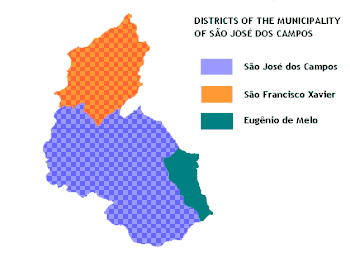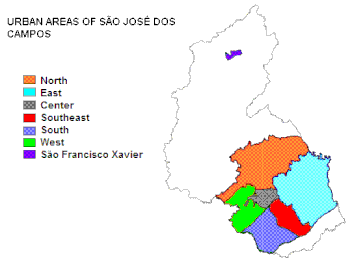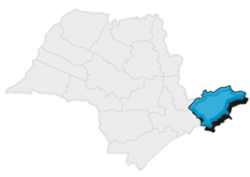
A | B | C | D | E | F | G | H | CH | I | J | K | L | M | N | O | P | Q | R | S | T | U | V | W | X | Y | Z | 0 | 1 | 2 | 3 | 4 | 5 | 6 | 7 | 8 | 9
This article needs additional citations for verification. (May 2014) |
São José dos Campos | |
|---|---|
| Municipality of São José dos Campos | |
From the top, from left to right: view of the city from the Presidente Dutra Highway; Vicentina Aranha Park; Residence of Olívio Gomes in Parque da Cidade; library of the Aeronautics Institute of Technology; Brazilian Aerospace Memorial; Technologic Park; panorama of the Altos da Esplanada region. | |
| Nicknames: Capital of the Valley and The Airplane Capital | |
| Motto(s): | |
 Location in the state of São Paulo and Brazil | |
| Coordinates: 23°10′44″S 45°53′13″W / 23.17889°S 45.88694°W | |
| Country | |
| Region | Southeast |
| State | |
| Metropolitan Region | Vale do Paraíba e Litoral Norte |
| Government | |
| • Mayor | Anderson Farias (PSD) |
| Area | |
| • Municipality | 1,099.409 km2 (424.484 sq mi) |
| • Urban | 298.99 km2 (115.44 sq mi) |
| Elevation | from 619 to 2.082 m (1,970 ft) |
| Population (2020)[1] | |
| • Municipality | 729,737 |
| • Density | 660/km2 (1,700/sq mi) |
| • Metro | 2,528,354 |
| GDP (PPP, constant 2015 values) | |
| • Year | 2023 |
| • Total | $30.0 billion[2] |
| Time zone | UTC−3 (BRT) |
| Postal Code | 12200-000 |
| Area code | +55 12 |
| HDI (2010) | 0.807 – very high[3] |
| Website | sjc |
São José dos Campos (Portuguese pronunciation: [sɐ̃w ʒuˈzɛ dus ˈkɐ̃pus], meaning Saint Joseph of the Fields) is a major city and the seat of the municipality of the same name in the state of São Paulo, Brazil. One of the leading industrial and research centers with emphasis in aerospace sciences in Latin America,[4] the city is located in the Paraíba Valley, between the two most active production and consumption regions in the country; São Paulo (80 km (50 mi) from the city) and Rio de Janeiro (320 km (200 mi)). It is the main city of the Metropolitan Region of Vale do Paraíba e Litoral Norte.[5] A native of São José dos Campos is called a joseense (Portuguese pronunciation: [ʒozɛˈẽsi]). Being the second most populous non-capital city in Brazil – behind Campinas – São José dos Campos lies in the middle of the Expanded Metropolitan Complex ("Complexo Metropolitano Expandido"), the first megalopolis in the Southern Hemisphere, with over thirty million inhabitants. The city's metro area also includes Greater São Paulo, Campinas, Santos and Sorocaba. The municipality concentrates many major companies and industries, such as Embraer, Panasonic, Johnson & Johnson, Ericsson, Philips, General Motors, Petrobras, Monsanto among others. São José dos Campos also holds relevant education and research institutions, as ITA, INPE, CEMADEN, IEAv, IEA, IFI, UNESP, UNIFESP, DCTA, FATEC, UNIVAP and IP%D, holding a position the puts the city as the main and largest Aerospacial Complex in Latin America. Thus, it is also considered the warlike producer centre. The Technological Park ("Parque Tecnológico de São José dos Campos"), the largest one in the country, is the only research institute in the world that converges all the three top global plane production companies, Embraer, Boeing and Airbus.
Geography
Area

- total area: 1,099.60 km2 (424.56 sq mi)
- urban area: 353.9 km2 (136.6 sq mi) (32.18%)
- rural: 745.7 km2 (287.9 sq mi) (67.82%)
Source: City administration website (in Portuguese) [6]
Borders
- Northern Border: Camanducaia, Sapucaí Mirim in Minas Gerais
- Southern Border: Jacareí, Jambeiro in São Paulo State
- Eastern Border: Monteiro Lobato, Caçapava in São Paulo State
- Western border: Igaratá, Joanópolis, Piracaia in São Paulo State
Metropolitan Area
The intense conurbation process has been creating a metropolis whose center city is São José dos Campos, reaching many other municipalities like Jacareí, Taubaté, Aparecida, Caçapava, Guaratinguetá, Campos do Jordão, Caraguatatuba, Pindamonhangaba and Lorena. The Paraíba Valley metropolitan area is currently made up of 39 cities, comprehending 2 453 387 inhabitants. The metro area is part of the Expanded Metropolitan Complex, being a megalopolis that connects São Paulo and Rio de Janeiro, encompassing São José dos Campos and Campinas with over 30 million inhabitants as a total number.
Cityscape

The municipality comprises three districts: São José dos Campos — the city itself, (also the seat), Eugênio de Melo and São Francisco Xavier. The last one is known for its natural sites and ecotourism.
The district of São José dos Campos is also subdivided into 2 subdistricts (São José dos Campos and Santana do Paraíba).
However, for administrative purposes, the city is composed of 7 urban regions: Center, North, South, West, East, Southeast and São Francisco Xavier.
Topography
Highlands predominate in the northern region of the municipality with altitudes ranging from 660 to 975 m (2,165 to 3,199 ft). The northern border of the municipality lies over the Serra da Mantiqueira Mountains (Mantiqueira Range), with some peaks reaching over 2000 meters (6500 ft.). The highest point in the municipality is known as 'Pico do Selado' at an altitude of 2082 meters.
In the urban area, there are rolling plateaus and hills. The lowest elevation in the city (and also in the municipality) is found in the Paraíba do Sul River, at a mean elevation of 550 m.
The municipality is bounded at the south by the 'Serra do Jambeiro' mountains, with an elevation of about 900m. Due to the high topographic differences among neighborhoods and the urbanization, the city now experiences micro-climates present in distant areas. The downtown tends to concentrate frequent urban heat islands, while the suburb areas get noticeably colder main temperatures. As the northern part of the city, mainly the district of Sao Francisco Xavier, mescles high attitudes and ecologically preserved areas the climate is better classified as Humid Subtropical Climate ("Cwb").
- Municipality: Elevations 550 to 2,082 m (1,804 to 6,831 ft)
- City: Elevations 550 to 690 m (1,800 to 2,260 ft).
The municipality holds the 11,559 hectares (28,560 acres) São Francisco Xavier Environmental Protection Area, established in 2002.[7] It contains part of the 292,000 hectares (720,000 acres) Mananciais do Rio Paraíba do Sul Environmental Protection Area, created in 1982 to protect the sources of the Paraiba do Sul River.[8]
Climate
| São José dos Campos | ||||||||||||||||||||||||||||||||||||||||||||||||||||||||||||
|---|---|---|---|---|---|---|---|---|---|---|---|---|---|---|---|---|---|---|---|---|---|---|---|---|---|---|---|---|---|---|---|---|---|---|---|---|---|---|---|---|---|---|---|---|---|---|---|---|---|---|---|---|---|---|---|---|---|---|---|---|
| Climate chart (explanation) | ||||||||||||||||||||||||||||||||||||||||||||||||||||||||||||
| ||||||||||||||||||||||||||||||||||||||||||||||||||||||||||||
| ||||||||||||||||||||||||||||||||||||||||||||||||||||||||||||
The climate of the city can be, perhaps, best described as a mix between the subtropical climate of southern parts of the country, the tropical climate of most of the country and the subtropical highland climate (in Portuguese: clima tropical de altitude) of neighbouring mountainous regions.
Technically, the city has a humid subtropical climate with significant less precipitation during winters (transitioning between Cfa and Cwa climatic types in the Köppen classification[9]). Winters are very mild, with average temperature in the coldest month near 17 °C. Summers are not excessively hot, with average temperature of the hottest month of 24 °C. Frosts are very rare, happening on average once per decade. However, fogs are pretty usual, occurring mostly during the winters. The peaks at the northern border of the municipality (some over 2000 m high) due to altitude have colder Cwb/Cfb climates, with very occasional snowfalls.[10]
With global warming it is very likely that the city's climate will transition in the near future (or has already transitioned) to a true tropical climate (type 'Aw' in the Köppen climate classification).
History
The origins of São José dos Campos lie at the end of the 16th Century when Jesuits founded a cattle farm, Aldeia do Rio Comprido. The farm was created through a concession of settlements around 1590 to the Society of Jesus. The farm was located on the banks of the Rio Comprido, natural division between São José and the city of Jacareí today.
| Historical populations | |
|---|---|
| Census year |
Population |
| 1940 | 36,279 |
| 1950 | 44,804 |
| 1960 | 77,533 |
| 1970 | 148,332 |
| 1980 | 287,513 |
| 1991 | 442,370 |
| 2000 | 539,313 |
| 2002 est. | 559,710 |
| 2004 est. | 589,050 |
| 2005 est. | 600,089 |
| 2006 est. | 610,965 |
| 2011 (IBGE) | 636,876 |
The farm status was an artifice to hide a religious outpost, one of the several Jesuit Reductions in Brazil, known for their resistance to enslavement, from the Portuguese expedition leaders and indigenous people hunters, known as the Bandeirantes.
On September 10, 1611, the local was officially recognized and the farmers precluded from utilizing the Natives as slaves. However, a turmeric conflict between farmers and the religious led to the expulsion of the Jesuits in 1640 from the region and the consequent dispersion of the mission.
Nevertheless, the Jesuits returned and reestablished a new settlement, where the current city center is spotted. It was about 15 km (9.3 mi) northeast of the previous mission, on a higher plain with a privileged view above a geological depression, which guaranteed security against invasions and floods. Again, despite being a new mission, it was officially treated as a cattle farm.
The initial urbanization plan is attributed to the Jesuit priest Manoel de Leão, whose main occupation was really to be an administrator of the community.
In 1692, documents named the village as Residência do Paraíba do Sul; in 1696 as Residência de São José.
At the beginning of the gold mining economic cycle in Brazil, the settlement goes through serious difficulties due to the exit of labor to the mines.
After the definitive expulsion of Jesuits from the Portuguese Empire in 1759, all the religious order's assets, such as farms, colleges and villages were taken under the Portuguese Crown's custody. The governor, D. Luis Antonio Botelho Mourão, had as a priority to turn these new assets into productive units and increase tax collection. For that, Boutelho Mourão successfully requested authorization from the Viceroy to create civil parishes, known as freguesias, and to change the fiscal status of villages to the category of Vila (town).
Then, on July 27, 1767, São José reached the official status of town, with a hall and a pillory, passing over the status of civil parish; and the name Vila de São José do Paraíba was formalized. But for many years it maintained the same rural characteristics. The main difficulty was the fact that the Estrada Real (Royal Road) passed by its limits, far from the village.
Cotton and coffee
In the middle of the 19th century, the village of São José do Paraíba had demonstrated some signs of economic growth through the development of agriculture. Cotton production evolved rapidly in the region, exported to the English textile industry. The production reached a peak in 1864.
In the same year, on April 22, the town became the seat of a municipality, acquiring finally, in 1871, the current name of São José dos Campos, followed by the creation of a judiciary district in 1872. Almost simultaneously, there was development of coffee crops in Paraíba Valley, which started to take off in 1870.
In 1886, after the opening of the Estrada de Ferro Central do Brasil railway (1877), the coffee production peaked. Then started to decay, running steady until the 1930s.
Hydro-mineral retreat and industrialization

The call for the municipality of São José dos Campos for the treatment of pulmonary tuberculosis by sanatoriums became noticed at the beginning of last century, due to its supposedly favorable climate conditions. The city became known as the Sanatorium City. The country's then-largest hospital, the Vicentina Aranha Sanitarium, was opened in town in 1924, and in 1935 the municipality was officially recognized as a health retreat.
With the advent of antibiotics in the 1940s, tuberculosis begins to be treated anywhere, thus ending the healthcare advantage carried out by São José, whereas the establishment of industries was about just to start.
The industrialization process of the municipality takes hold from the installation of the Technological Institute of Aeronautics in 1950 and also with the opening of the Dutra Highway (BR-116), thus making possible a faster connection between Rio de Janeiro and São Paulo and cutting into the urban area of São José dos Campos. Altogether, these factors allowed the municipality to make strides towards fulfilling its scientific and technological potential.
Government
São José dos Campos has a "strong mayoral" system in which the mayor is vested with extensive executive powers, as it is in all municipalities in Brazil. The mayor is elected to a four-year term by universal voting. The City Council is elected every four years with the mayor.
The state administrative region of São José dos Campos

The State of São Paulo is divided politically and administratively into 15 regions. São José dos Campos is the seat and the name of the 3rd Administrative Region, which includes the North Coast of São Paulo state and the Paraíba Valley.
The region comprises 39 municipalities with sharp contrasts. São José dos Campos is a densely populated city, with approximately 2,100 inhabitants/square kilometers in urban area, whereas the quiet municipality of São José do Barreiro has only seven inhabitants/square kilometer. [citation needed] There are both highly industrialized cities and the others in the region are focused on agriculture and tourism. São José dos Campos is well known as the Capital do Vale which means that São José dos Campos is the most important city of the Paraíba Valley.
It is one of the state's most dynamic areas, the fourth one in terms of population density, and covers 11.3% of the state's territory. The main municipalities are São José dos Campos, Taubaté, Jacareí, Guaratingueta, Caraguatatuba, Campos do Jordão, São Sebastião, Lorena, Pindamonhangaba, Ubatuba and Caçapava.
- Population of the region: 2,243,687 (est. 2018/IBGE)
- Population Density: 288.56 inhabitants per square kilometer
List of mayors
- João Cursino (1908/1910, 1913/1916, 1919/1930)
- Rui Dória (1931)
- Francisco José Longo (1938/1941)
- Elmano Ferreira Veloso (1949/1950, 1953/1956, 1958/1961, 1966/1970)
- Jorge Zarur (1947 and 1950)
- José Marcondes Pereira (1962/1966)
- Sérgio Sobral de Oliveira (1970/1975)
- Ednardo José de Paula Santos (1975/1978)
- Joaquim Vicente Ferreira Bevilacqua (1978/1982, 1989/1990)
- Hélio Augusto (1986)
- Ângela Guadagnin (1993/1996)
- Emanuel Fernandes (1997/2000, 2001/2004)
- Eduardo Cury (2005/2008, 2009/2012)
- Carlinhos Almeida (2013/2016)
- Felicio Ramuth (2017/-)
Sites
Several fairs and expositions are done at the two pavilions located in the city.
A list of notable sites:
- Augusto Ruschi Biological Reserve
- Burle Marx Municipal Park with the Olivo Gomes residence
- CTA and MAB (Brazilian Aerospace Memorial)
- Espaço Mário Covas (former City Council seat)
- INPE – (National Institute for Space Research)
- Sanatorium Vicentina Aranha
- Santos Dumont Park (total area: 46.347 m2)
Entertainment, leisure and sports
Although São José is an industrial center, the city still preserves green areas and quiet town districts. Around 62% of the area from the municipality is characterized as an environmental preservation area. [citation needed] On the outskirts of the urban area, Augusto Ruschi Ecology Reserve has many local plant species. The natural reserve has 2,500,000 m2 (27,000,000 sq ft), being a government protect area for the local flora. São Francisco Xavier is a community the offers many of those attributes as well.
Furthermore, there is an easy access to the mountain cities (Campos do Jordão, Santo Antônio do Pinhal) and to the beaches of the Northern Coast of São Paulo, being both of the areas in a distance of only 80 km from São José dos Campos.
The city has three major parks and several sports and country clubs. Tenis Clube and Associação Esportiva São José have hosted the 35th Banana Bowl International Tennis Federation Juniors Circuit in 2005 and 2006. [citation needed]
A soccer stadium, called Estádio Martins Pereira, is the home ground of São José Esporte Clube, a professional soccer team.
Notable teams from the city:









